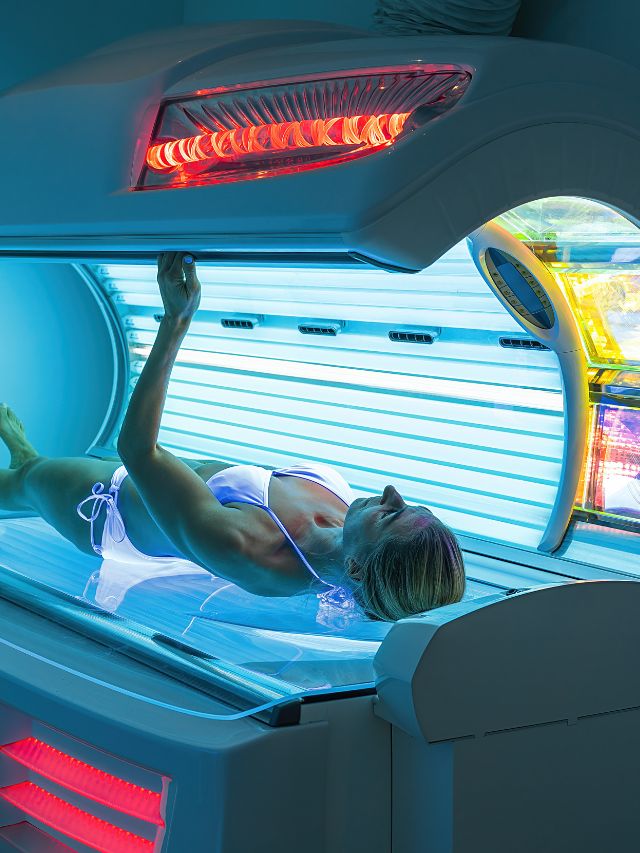The Difference Between A Bronzing Bed vs Tanning Bed
Stepping into the world of indoor tanning can be a bit overwhelming, especially when it comes to choosing between a bronzing bed and a regular tanning bed.
Both aim to give you a sun-kissed glow, but there are key differences to consider.
We are here to demystify the main differences between these two popular indoor tanning methods.
Here is the scoop on a bronzing bed vs tanning bed!
Understanding UV Light and Rays
Both bronzing beds and regular tanning beds use UV light for the tanning process. UV light is a type of ultraviolet light that mimics natural sunlight.
There are two types of UV rays involved: UVA and UVB light. UVA rays are of a longer wavelength that penetrates deeper into the skin to stimulate melanin production, resulting in a darker tan.
UVB rays, on the other hand, have a shorter wavelength and affect the top layers of skin, causing skin damage with excessive exposure.
Bronzing Beds: A Walkthrough
Bronzing beds, also known as bronzer beds or bronzer tanning beds, use a combination of UVA and UVB light, but with a higher concentration of UVA light and less UVB.
These bronzing bulbs are designed to emit a longer wavelength, resulting in a deeper tan that lasts longer compared to regular tanning beds.
Special features of bronzing beds include bronzing bulbs, high pressure lamps, and often, luxury models come with air conditioning for added comfort during tanning sessions.
The bronzing bed’s UV radiation is formulated to reduce the risk of skin cancer. Bronzing beds are a rapid solution for those seeking a quick result, often delivering a golden tan in shorter, minute sessions.
However, it’s essential to ensure the bronzing bed’s maximum session time aligns with your skin type, especially if you have fair skin.
Regular Tanning Beds: A Walkthrough
Traditional tanning beds, also known as conventional tanning beds or normal tanning beds, use a combination of UVA and UVB light as well, but with a higher concentration of UVB light.
Regulat tanning lamps emit a shorter wavelength, affecting the top layer of skin and resulting in a base tan.
These regular tanning beds are typically slower, requiring multiple tanning sessions to achieve an intense tan.
Regular tanning beds use tanning bulbs and UV lamps, which differ from the bronzing bulbs used in bronzer beds.
Some high-end models may feature facial lamps and different types of bulbs for a more uniform tan.
Despite their slower process, regular tanning lamps are often preferred for their ability to stimulate Vitamin D production.
Bronzing Bed vs Tanning Bed: The Big Differences
The main difference between a bronzing bed and a regular tanning bed lies in their UV light composition.
Bronzing beds use a higher proportion of UVA light and lower amounts of UVB rays, resulting in a deeper, longer-lasting tan.
On the other hand, regular tanning beds use more UVB light, resulting in a base tan that requires more frequent tanning sessions to maintain.
Another difference is the tan time. Bronzer beds offer a faster tan due to their higher pressure beds and longer wavelength, while regular tanning beds take much time due to their lower pressure beds and shorter wavelength.
Choosing the Perfect Tanning Method
Bed Types: Bronzing Beds vs. Traditional Tanning Beds
When deciding on the best way to achieve a bronze tan, it’s essential to understand the different bed types available in tanning salons across the United States. The two main types are bronzer beds and traditional tanning beds.
Bronzer beds, as we’ve discussed, deliver a deeper, long-lasting tan due to their high-pressure beds and bronzing ray technology.
They utilize a specific combination of UV bulbs and light bulbs designed to maximize exposure time and ensure safer results.
On the other hand, traditional tanning beds, also known as conventional tanning beds, are often favored by first-time users for their familiarity and the base tan they offer.
These beds typically use a higher number of bulbs, which emit ultraviolet rays to stimulate a base tan.
Tanning Booths: An Alternative Option
For those uncomfortable with lying down during their tanning sessions, tanning booths offer an alternative.
Tanning booths work much like the best tanning beds, providing a controlled environment for UV exposure.
However, booths often lead to more even tans with fewer tan lines due to their 360-degree exposure.
High Pressure Beds
High-pressure beds, often found in premium tanning salons, offer a more intense tanning experience by utilizing a higher proportion of UVA rays.
These high pressure units are designed to deliver quicker and deeper tanning results, making them a popular choice for those seeking to achieve a darker tan in a shorter time.
Managing Exposure Time and UV Levels
Regardless of the bed type you choose, managing your exposure time is crucial to prevent skin damage and allergic reactions.
It’s crucial to start with shorter sessions and gradually increase the exposure time to allow your skin to adapt to the UV radiation.
Remember that different levels of tanning beds offer varying UV intensity. High-pressure units tend to have a higher percentage of UVA rays for a quicker, deeper tan, while base beds emit more UVB rays for a more gradual, safer tan.
Spray Tan: A UV-Free Alternative
For those concerned about UV radiation or seeking temporary results, spray tans are a great alternative.
Spray tans work by applying a solution that stimulates a tan without the use of any types of rays, offering a safer method without the risk of maximum exposure to UV radiation.
Safety and Skin Care
While both types of beds offer a way to achieve a healthy-looking tan without direct sunlight, it’s essential to note that overexposure to UV radiation can lead to skin damage and increase the risk of skin cancer.
The American Academy of Dermatology suggests limiting the use of tanning beds and recommends using indoor tanning lotions to protect skin cells.
High-Pressure Beds: A Deeper Dive
High-pressure beds are commonly found in both bronzer and traditional indoor tanning beds.
These beds, also known as high-pressure units, are characterized by their ability to deliver a more intense tanning experience.
High-pressure beds utilize a higher proportion of UVA rays, which penetrate deeper into the skin, promoting the production of melanin and thus, a darker tan.
It’s important to note that while high-pressure beds can deliver quicker results, they also require careful usage due to the intensity of the UV radiation.
As always, it’s essential to manage your exposure time appropriately to prevent skin damage.
Allergic Reactions and Indoor Tanning
While indoor tanning beds offer a controlled environment for achieving a sun-kissed glow, they are not without risks.
One such risk is the possibility of an allergic reaction. Some individuals may be sensitive to the UV radiation emitted by the beds, leading to skin rashes, itching, or other adverse reactions.
It’s crucial to test your skin’s reaction to tanning beds, starting with shorter sessions and gradually increasing if no adverse reactions occur.
The Role of Nitric Oxide in Tanning
Nitric oxide is a compound our bodies naturally produce and it plays a significant role in the tanning process.
When our skin is exposed to UV radiation, the body releases nitric oxide, which helps stimulate the production of melanin, the pigment responsible for tanning.
However, excessive UV radiation can lead to an overproduction of nitric oxide, leading to skin damage.
Therefore, it’s essential to balance your tanning sessions to enjoy the benefits of nitric oxide without overexposing your skin to harmful UV radiation.
Things To Remember
The primary difference between a bronzing bed and a tanning bed lies in the type of UV rays and bulbs utilized.
Bronzing beds use higher levels of UVA rays that penetrate deeper into the skin, producing a darker and longer-lasting tan compared to tanning beds.
The primary difference between a bronzing bed and a tanning bed lies in the type of UV rays and bulbs utilized.
Bronzing beds use higher levels of UVA rays that penetrate deeper into the skin, producing a darker and longer-lasting tan compared to tanning beds.
However, it’s crucial to emphasize that both types of beds involve exposure to UV rays, which can pose risks to skin health.
Ultimately, the choice between a bronzing bed and a tanning bed should be based on personal preferences, budget, and skin type, as well as taking into consideration the potential health risks.
Final Thoughts
Achieving the perfect skin color lies in understanding the various tanning options available and choosing the one that best suits your skin type and tanning goals.
Whether you prefer the deep, long-lasting tan of a bronzer bed or the gradual, natural-looking tan from a conventional tanning bed, always prioritize your skin’s health.
Remember, the first time you tan can be a bit overwhelming. However, with the right information and a cautious approach, you can achieve a beautiful, healthy glow.
Ultimately, the best tanning bed for you depends on your skin type, desired tan depth, and how much time you’re willing to invest in your tanning sessions.
Whether you favor bronzer beds for their quick results and open design, or regular tanning beds for their Vitamin D benefits and traditional comfort, the best thing is to ensure you’re protecting your skin during the tanning process.
Consider your options carefully, and enjoy the journey to achieving that healthy glow!
For more great scoop, check out these articles:
















